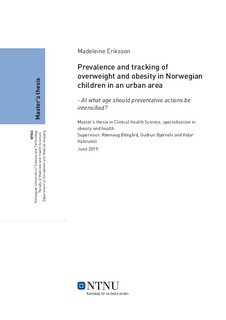| dc.description.abstract | Background: Obesity is a severe threat to health and wellbeing. Worldwide, overweight and obesity have almost tripled since 1975. In Norway, the prevalence of overweight and obesity have started to level off. However, the prevalence is still too high, and prevention and treatment are exceedingly important. High birth weight or high BMI early in life has been associated with overweight or obesity later in life. There is an urban-rural gradient in Norway, which indicates of a lower proportion in cities with high degree of centrality. However, there are limited studies of the prevalence and tracking in a Norwegian urban municipality. Aim: The aim of the study was to investigate how the prevalence of children with overweight and obesity (born between 2003 to 2010) changes between different ages (two, four and eight) in an urban municipality, and to analyse the odds for overweight or obesity at eight years of age according to weight categories (normal weight, overweight or obese) at the ages two and four. Method: The study was a descriptive and analytic retrospective registry study based on longitudinal data from health stations in Trondheim. A total of 7 643 children with observations at the ages two, four and eight were included. Iso-body max index (BMI), BMI-z-score, age, gender and year of birth were variables used in the study. Iso-BMI is adjusted for age and gender and defines overweight as iso-BMI ≥25-˂30, obesity grade I as iso-BMI≥30-˂35 and obesity grade II as iso-BMI≥35. Associations were measured with logistic regression and for proportions, margins were used. Results: The prevalence of overweight was 10% at two years of age, 8.4% at four years of age and 12.7% at eight years of age and obesity grade I was 1.2%, 1% and 2.6%. In boys, obesity grade II increased fourth fold from the age of two to eight. The majority with overweight or obesity at the age of eight were normal weight at two and four years of age. The chance for overweight or obesity at the age of eight were 51% higher if normal weight at two years of age and overweight or obese at the age of four compared to normal weight at both the ages two and four years. Also, being overweight or obese at the age two and normal weight at the age of four resulted in a 15% higher chance for overweight or obesity at the age of eight compared to normal weight at both the ages two and four. Conclusion: The results in this urban population-based study indicated that being overweight or obese at four years of age, the chance for overweight or obesity at eight years of age was high. But, an increased risk for overweight or obesity at the age of eight was also presented if overweight or obese at the age of two, even with normal weight at four. The prevalence of overweight and obesity was comparable with data on a national level. A gender difference was shown with a higher proportion of overweight in girls compared to boys. However, in obesity grade I and II, boys presented the highest proportions. | |
